This Pomodoro Sauce (the authentic and the quick recipes) is a smooth, thick, and flavorful tomato sauce that you can make in 30 minutes and pairs well with pasta dishes like our penne Pomodoro among other dishes such as this Margherita pizza and spaghetti with meat sauce!
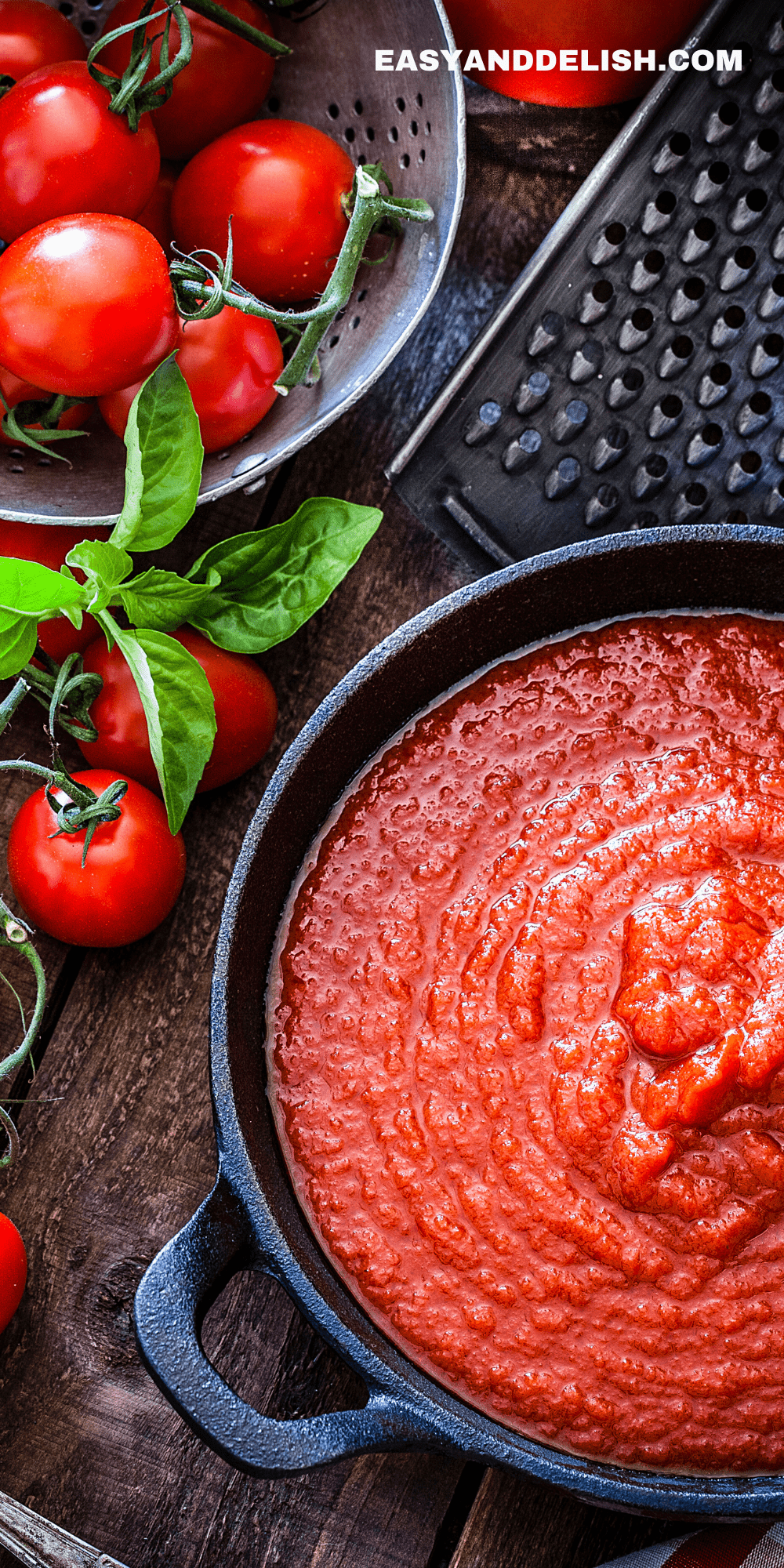
Are you a pasta lover? Well, me too!
Although on a low-carb diet because of my PCOS, I enjoy making my pasta sauces from scratch and have them with low-carb pasta or whole wheat pasta!
It tastes better than the store-bought pasta sauces.
Of course, the flavor of homemade pasta sauce will depend on the quality of the ingredients and the time they were stewed.
If you use good ingredients, you can cut down the cooking time without compromising the final flavor of the sauce.
Although a classic Italian Pomodoro sauce may take usually around 45 minutes to prepare and cook, we are making ours in just 30 minutes from start to end (10 minutes to prep and 20 minutes to cook).
If you don’t have half an hour to spare, don’t worry! We also offer an option to prep and cook a quick Pomodoro sauce for 15 minutes total with ingredients you already have in your pantry. 😉
Ready for this Italian recipe?
Table of Contents
- 1 What Is Pomodoro Sauce?
- 2 Difference Between Pomodoro Sauce and Marinara Sauce
- 3 Difference between Pomodoro and Bolognese Sauce
- 4 Ingredients and Substitutions
- 5 How to Make Pomodoro Sauce
- 6 Is Italian Pomodoro Sauce Spicy?
- 7 Tips
- 8 Is Authentic Pomodoro Sauce Vegetarian?
- 9 Can I make this Pomodoro Sauce Recipe ahead of time?
- 10 Storage
- 11 What to make with leftover sauce
- 12 Pasta Recipes with Tomato Sauce
- 13 Pomodoro Sauce
- 14 Storage
What Is Pomodoro Sauce?
Pomodoro sauce (or sugo di pomodoro) is a simple classic Italian tomato-based sauce recipe consisting of fresh tomatoes (or canned passata, crushed tomatoes), extra-virgin olive oil, garlic, onion, and basil.
Pomodoro literally means, “tomato” in Italian.
It usually comes together in 30 to 45 minutes.
Difference Between Pomodoro Sauce and Marinara Sauce
Both are Italian sauces! The biggest difference between Pomodoro sauce and marinara sauce is the texture/thickness.
While marinara is chunky and a little runny, Pomodoro sauce is smooth and thick.
Moreover, their ingredients can vary as well. Marinara calls for a few more ingredients such as oregano and sometimes red pepper flakes (spicy marinara).
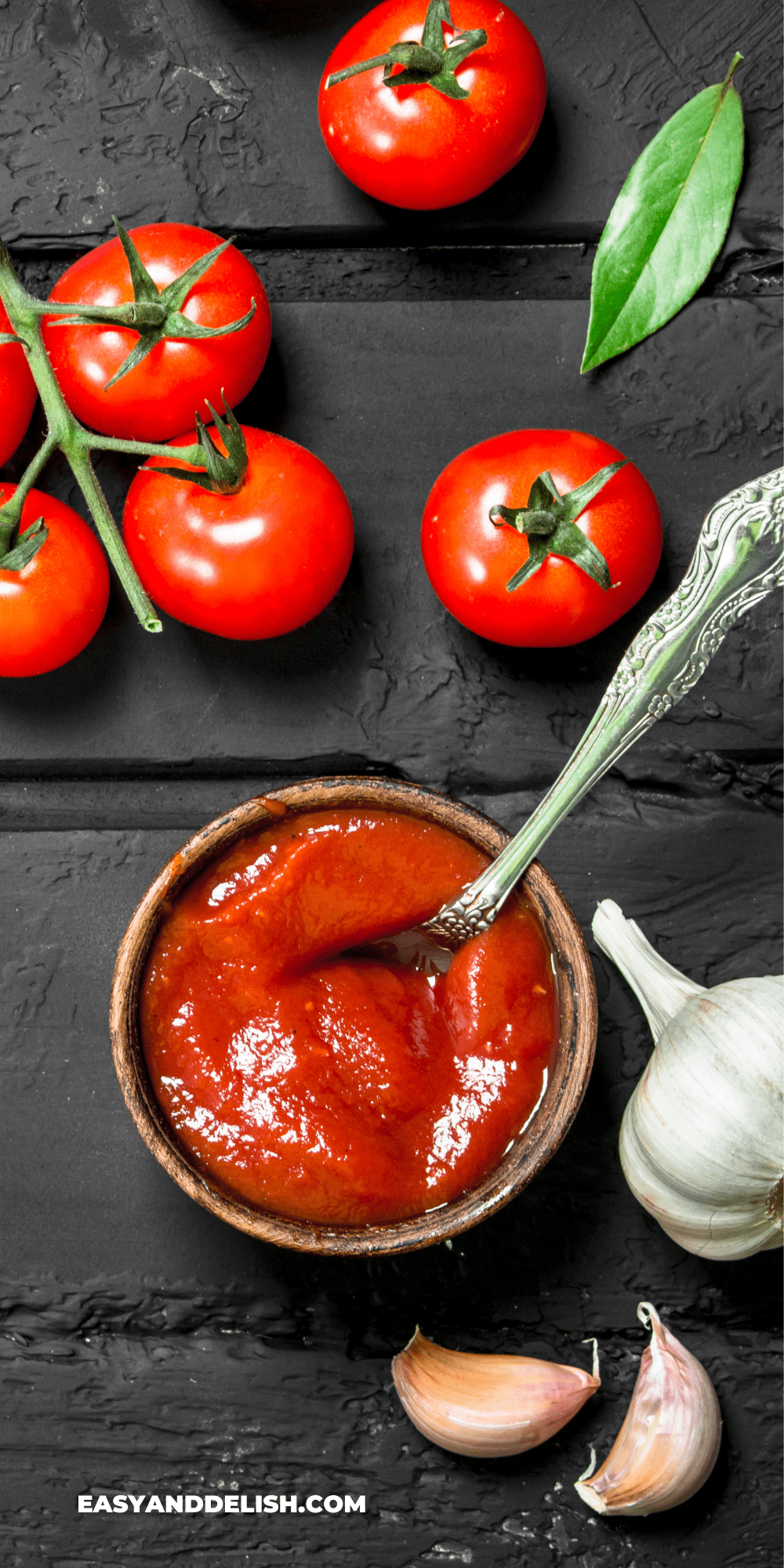
Difference between Pomodoro and Bolognese Sauce
A bolognese means “meat sauce.” The main ingredient is ground meat! For a Pomodoro sauce, the tomatoes are the star.
The main difference between them is that the bolognese has ground beef and the Pomodoro sauce doesn’t.
Ingredients and Substitutions
Pomodoro sauce calls for a few simple, fresh ingredients:
- Tomatoes: For the classic Pomodoro sauce, you can use either fresh, peeled tomatoes or canned San Marzano crushed tomatoes (passata). If you use fresh tomatoes, you may have to blend them first in order to incorporate them into the sauce or blend the sauce at the end so it will be smooth. But if you decide to use canned crushed tomatoes, they will dissolve while cooking and the sauce will wind up smooth. For the quick version, you may use a jarred tomato sauce combined with tomato paste. You want a quality ingredient because tomato is the base of this homemade sauce.
- Olive oil: You may replace it with extra-virgin olive oil that has a fresh, fruity flavor.
- Garlic: Use fresh garlic cloves You can use halved garlic that you can remove at the end of the cooking time or minced garlic that will flavor the sauce even more.
- Onions (optional): Although optional, yellow onions add more flavor to the sauce. For a quick Pomodoro sauce, use onion powder!
- Fresh basil leaves: Italians usually use the leaves whole or torn in half to hold on to their natural oils. But for a quick version, you may thinly slice the leaves and incorporate them into the sauce right away before stewing.
- Salt and black pepper: Besides these 2 basic seasonings, some add a pinch of sugar to balance the acidity of the tomatoes. If you are on a low-carb diet, do not add sugar to yours.
How to Make Pomodoro Sauce
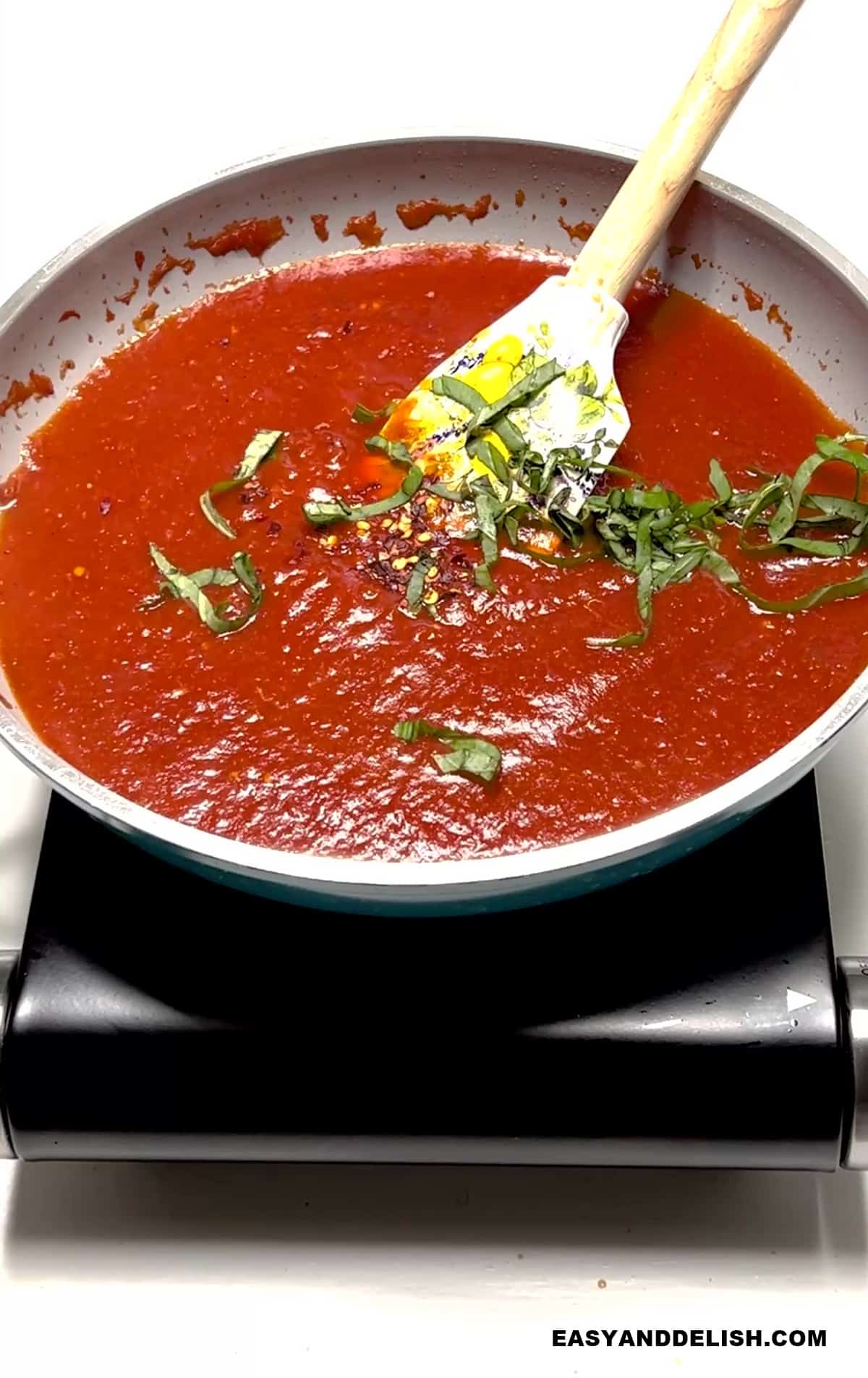
Classic Pomodoro Sauce:
- Heat a saucepan over low to medium heat, add the olive oil and cook the onion for about 3-4 minutes or until translucent. Add the garlic and cook for 1 minute.
- Stir in the tomatoes, basil, salt, and pepper. Cover the pan and let the mixture simmer over medium heat for 20 minutes, stirring now and then, or until the Pomodoro sauce has thickened.
- Toss with cooked pasta or gnocchi and parmesan cheese, or use as a topping for pizzas.
Quick Pomodoro Sauce:
- Heat a no-stick saucepan pan over medium heat. Then add olive oil and sauté the garlic for about 1 minute, stirring now and then, or until fragrant.
- Stir in tomatoes, tomato paste, onion powder, salt, pepper, red pepper flakes (optional), and basil.
- Simmer on medium-low heat for 8-10 minutes. Use an immersion blender, food processor, or blender to smooth the sauce if needed.
NOTE: We used onion powder instead of minced onions for the quick Pomodoro sauce because it cuts off 4-5 minutes of the cooking time. Because we simmered the sauce half the time we simmered it in the classic version, we added tomato paste to the sauce to boost its flavor as well as red pepper flakes.
Is Italian Pomodoro Sauce Spicy?
Pomodoro sauce is not traditionally spicy! However, there are recipes that call for red pepper flakes. You can customize it according to your taste!
Tips
- Just like any good sauce, if you let it simmer longer, it’ll help concentrate those rich tomato flavors.
- The longer you can stew the tomatoes for the sauce the better it will taste.
- You may add a pinch of sugar to your sauce in order to balance the acidity of the tomatoes if you are not on a keto diet.
- Preferably use whole basil leaves or torn in half to preserve its natural oils.
- If you are not a garlic fan, you may cut the cloves in half and remove them after cooking the sauce… instead of adding minced garlic to the sauce.
Is Authentic Pomodoro Sauce Vegetarian?
A classic Pomodoro sauce recipe is both vegetarian and vegan! There is no meat in it like like in the Bolognese sauce.
Can I make this Pomodoro Sauce Recipe ahead of time?
Yes, you can! Allow the sauce to cool and store it in an airtight container in the fridge for up to a week. Just reheat it when you are ready to serve it. Season with salt again if needed!
Storage
- Store the Pomodoro sauce in an airtight container in the fridge for up to 7 days.
- Freeze it for up to 3 months. Let it cool and then place the sauce in plastic freezer bags (or containers) and lay them flat in your freezer. When they are frozen, stand them up to save room.
- Thaw in the fridge! (it may take up to 24 hours)
- Reheat in a pan over low heat until hot. Adjust seasonings like kosher salt if needed!
What to make with leftover sauce
- Pizza- Use it as a pizza sauce! Add the extra sauce on top of pizzas like this breakfast pizza or flatbreads instead of marinara.
- Soup- Use tomato-based soups such as this spicy tomato shots, cabbage soup diet recipe, and chicken tortilla soup to replace chopped or canned tomatoes.
- Dip for sandwiches or pasta chips-Warm this sauce up and use it as a dip for grilled cheese and other sandwiches.
- Other pasta sauces- you can add meat to make a Bolognese sauce, or use it as a simple spaghetti sauce and add extra fresh herb.
- Others: You can use the Pomodoro sauce to make chicken parmesan, shakshuka, chicken enchiladas, zucchini lasagna, mushroom curry, shrimp a la diabla, or as a base for Spanish rice.
Pasta Recipes with Tomato Sauce
- Pasta Bolognese
- Gigi Hadid Pasta
- Homemade Bow Tie Pasta with Tomato and Basil Sauce
- Whole Wheat Penne in Tomato Sauce
PIN & ENJOY!
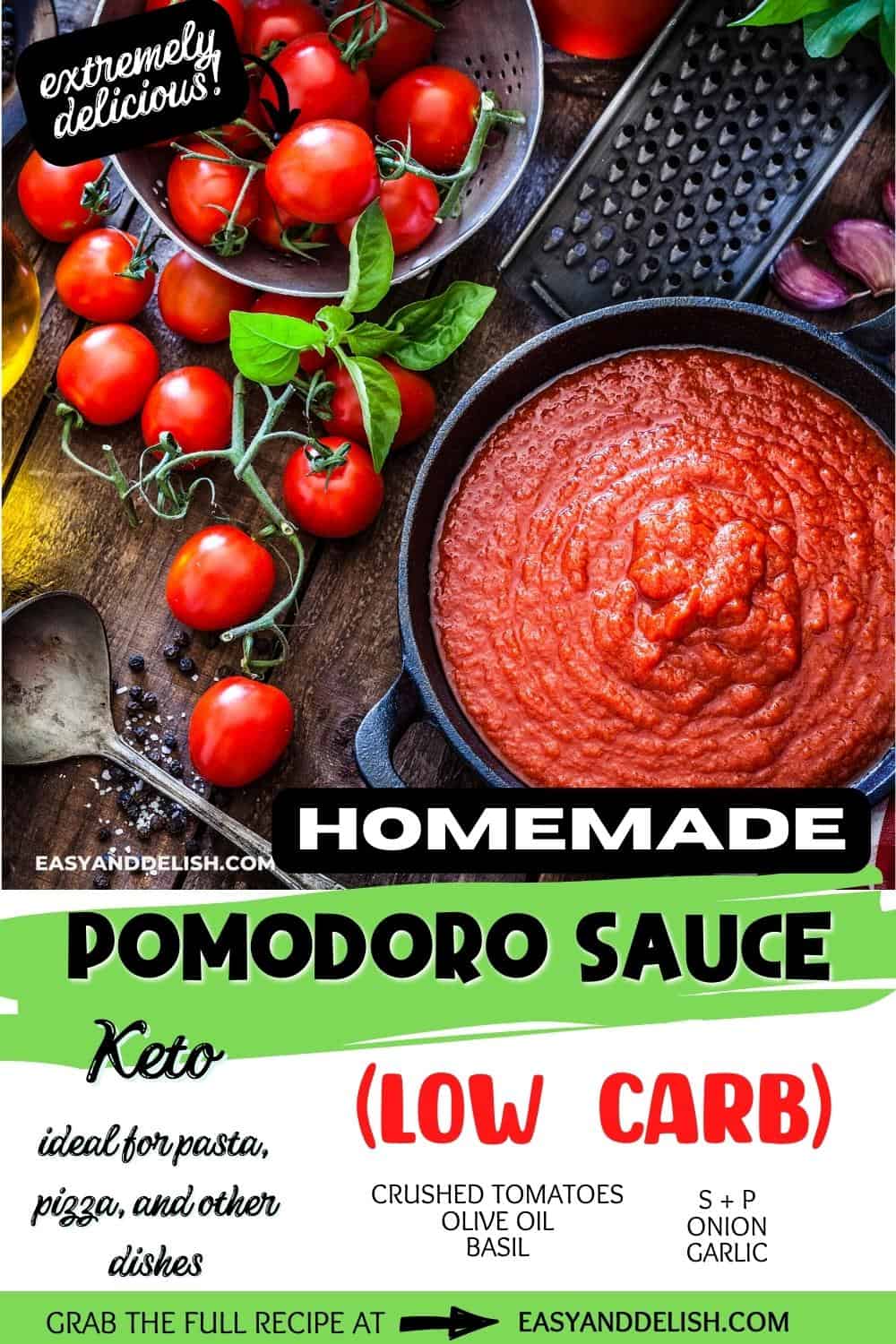
Pomodoro Sauce
Equipment
- 1 cutting board
- 1 Chef's knife
- 1 saucepan
- 1 wooden spoon
- blender optional
Ingredients
- 2 tablespoons extra-virgin olive oil or olive oil
- 1 yellow onion finely minced
- 4 cloves garlic finely minced or grated
- 28 oz can San Marzano crushed tomatoes (or canned whole peeled tomatoes that you can blend in the blender before cooking)
- ¼ cup fresh basil torn in half
- Salt and pepper to taste (if you are NOT on a low-carb diet, you may add a pinch of sugar to balance the acidity of the tomatoes)
Instructions
Classic Pomodoro Sauce:
- Heat a saucepan over low to medium heat, add the olive oil and cook the onion for about 3-4 minutes or until translucent. Add the garlic and cook for 1 minute.
- Stir in the tomatoes, basil, salt, and pepper. Cover the pan and let the mixture simmer over medium heat for 20 minutes, stirring now and then, or until the Pomodoro sauce has thickened.
- Toss with cooked pasta or gnocchi and parmesan cheese, or use as a topping for pizzas.
Quick Pomodoro Sauce:
- Heat a no-stick saucepan pan over medium heat. Then add olive oil and sauté the garlic for about 1 minute, stirring now and then, or until fragrant.
- Stir in tomatoes, 2 tablespoon tomato paste, 2 teaspoon onion powder, salt, pepper, 1 teaspoon red pepper flakes (optional), and basil.
- Simmer on medium-low heat for 8-10 minutes. Use an immersion blender, food processor, or blender to smooth the sauce if needed.
Recipe Notes
Storage
Store the Pomodoro sauce in an airtight container in the fridge for up to 7 days. Freeze it for up to 3 months. Let it cool and then place the sauce in plastic freezer bags (or containers) and lay them flat in your freezer. When they are frozen, stand them up to save room. Thaw in the fridge! (it may take up to 24 hours) Reheat in a pan over low heat until hot. Adjust seasonings like kosher salt if needed!Nutrition
** Nutrition labels on easyanddelish.com are for educational purposes only. This info is provided as a courtesy and is only an estimate, since the nutrition content of recipes can vary based on ingredient brand or source, portion sizes, recipe changes/variations, and other factors. We suggest making your own calculations using your preferred calculator, based on which ingredients you use, or consulting with a registered dietitian to determine nutritional values more precisely.
Please note that health-focused and diet information provided on easyanddelish.com is for educational purposes and does not constitute medical advice, nor is it intended to diagnose, treat, cure, or prevent disease. Consult with your doctor or other qualified health professional prior to initiating any significant change in your diet or exercise regimen, or for any other issue necessitating medical advice.




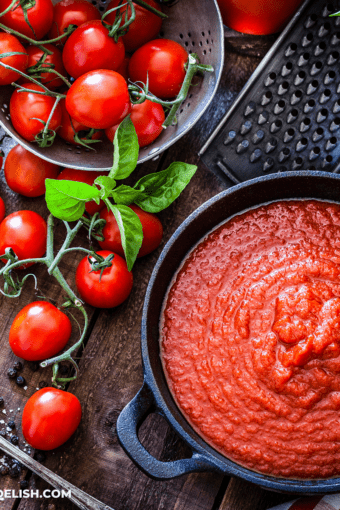
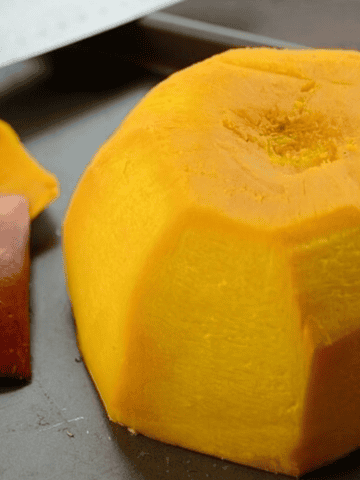


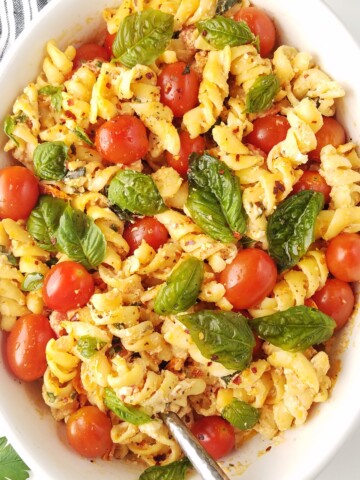
Leave a Reply